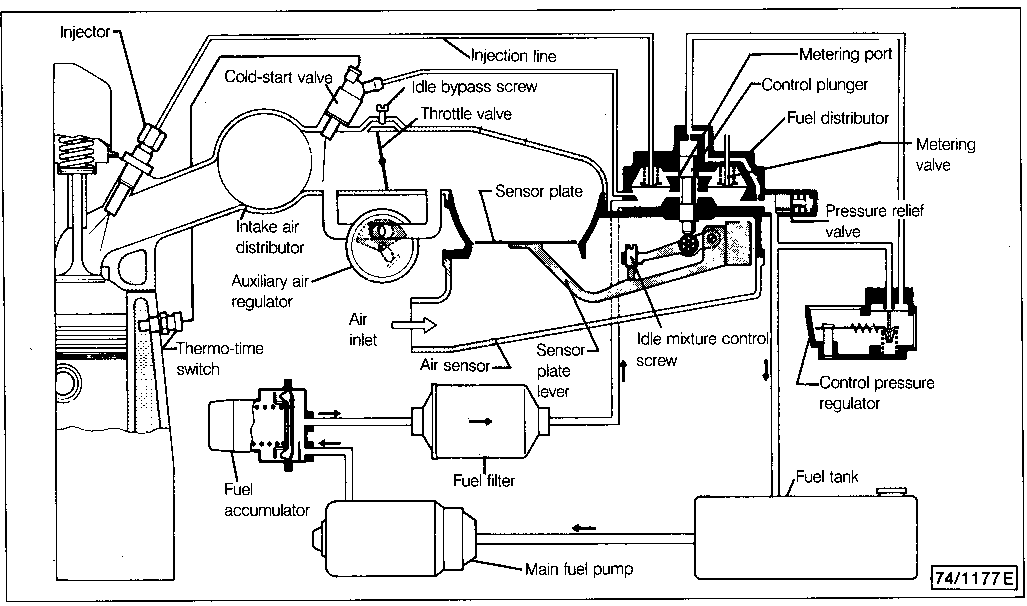
Here's a schematic of an early VW Rabbit's mechanical CIS system.
created Oct 18, 2001
CIS is made by Bosch and has been in use since the mid 70's on VWs and many other european cars. It stands for Continuous Injection System, which means that fuel is continually atomized into the intake manifold just upstream of the intake valve. Fuel flow is directly controlled by airflow through a mechanical connection to an air vane which in turn moves a plunger which regulates fuel flow. Pure CIS is altitude compensating to some extent, since when less air flows, less fuel flows. You could also dispense with carb heat since there is no venturi, and the primer since the cold start valve is built in. Decreased workload is always a good thing.

Here's a schematic of an early VW Rabbit's mechanical CIS system.
The control pressure regulator (fuel enrichment for cold starting and altitude compensation) is also mechanical, but can be electrically heated for "choke turnoff". The fuel pump delivers about 75 psi, which has never been a problem on cars since the injector lines are braided stainless steel from the factory, and "never" fail. The pumps are extremely reliable and give fair warning by insufficient delivery at high speeds.
A later version of CIS named CIS-E (E is for Electronically fine tuned) has a lighter aluminum fuel distributor body, rather than CIS's steel version. It also has a differential pressure regulator built in that adjusts the mixture electronically based on input from the oxygen sensor. This would be even better for altitude compensation, but when that sucker quits (or the connector falls off), you better be over a good landing spot. I once went around a curve at the limit in my 16V Scirocco and the centrifugal force let the connector come loose (which I hadn't connected properly earlier) and I thought I was going to have to push it home. That's the downfall with CIS-E. It CAN leave you walking if one wire falls off. That can't happen with "pure" CIS, unless you run out of electricity to power the pump.
Having said all of this, CIS is extremely reliable as it came from the factory. Most cars go their entire lives with no more maintenance than changing the fuel filter every 30,000 miles, and most probably never even get THAT! If I were planning on using CIS for the for Corvair, I'd look for BMW, Mercedes, or some other 6 cylinder systems since their fuel distributors already have 6 lines running out of them, although given the goofy Corvair intake manifold, a four banger version would probably work just fine plumbed directly into the manifold. If you want to know more about Bosch fuel injection (in excruciating detail), go to www.rb.com and buy "Bosch Fuel Injection & Engine Management".
The downside to CIS is that it weighs at least 15 pounds more than a carburetor when you count the pump, accumulator, etc, even when you consider the weight savings of ditching the carb heat box and primer.. And the CIS equipment is fairly large, so you better have a lot of room for it under the cowling. I suspect that the benefits don't "outweigh" the extra weight, and I'm surely not going to go that far out on a limb during first flights with a highly modified airframe and engine too. There is some concern about g-loads affecting the vane (and thus fuel distribution) during abrupt turns or manuevers, but the thing is counterweighted so that shouldn't be an issue.
I don't know of a single person who's flying behind CIS. I suspect weight, size, and complexity are the main reasons why. And it would probably take me another year to set up the CIS properly, even though I'm probably as qualified as anybody to pull it off. On the other hand, I could just bolt a carb on in a few minutes, so you can see why I've shelved that plan for a while, probably forever. Meanwhile, I'm headed back to the basement to get some work done...
return to Mark Langford's Corvair engine